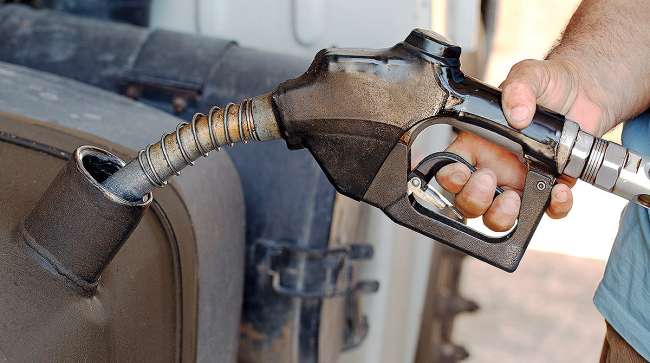Senior Reporter
Diesel Price Slips 1.9¢ to $3.047 a Gallon

[Stay on top of transportation news: Get TTNews in your inbox.]
The U.S. average retail price of diesel slipped 1.9 cents to $3.047 a gallon, the Department of Energy reported Oct. 7, marking the third consecutive decline whereby the price has fallen 3.4 cents a gallon in the period.
The price of oil fell ahead of U.S.-China trade negotiations that are scheduled to resume Oct. 10, as lingering uncertainty on key fronts prevailed.
Trucking’s main fuel costs 33.8 cents less than it did a year ago, when it was $3.385, DOE said.
All regions saw the average price fall, except California, where the price rose 0.5 cent to $3.981.
Also, the national average price for regular gasoline inched up 0.3 cent to $2.645 a gallon, DOE’s Energy Information Administration said.
All regions, except three in the West plus the Midwest, saw average gasoline prices fall.
One company said fuel efficiency in diesel engines can improve with closer attention to filters.
Donaldson Co. said its Filter Minder connected technology can save up to $450 per longhaul truck annually, on average, by prompting filter changes based on filter condition versus scheduled maintenance intervals.
The company was founded in 1915 when it developed a simple air cleaner to solve a farmer’s tractor engine problems.
It said, compared with filters marketed as comparable, its PowerCore brand of air filter retains 26% more contaminants, but its straight-through airflow is 27% less restrictive, which saves fuel.

Kloza
Meanwhile, another company tracking fuel and oil trends expects the period between 2020 and 2029 to bring the greatest disruption fuel markets have witnessed since the 1970s and the Arab Oil Embargo.
“That prediction is not necessarily based on the substitution of electrons as the fuel of choice that may displace hydrocarbons or biofuels. There will be global nooks and crannies where electric vehicles replace the internal combustion engine, but abandonment of traditional fuels may come in fits and starts until after 2030,” Tom Kloza, co-founder and global head of energy analysis for Oil Price Information Service, wrote in a blog. OPIS provides pricing and information on diesel, gasoline, jet fuel, oil, liquefied petroleum gas and energy commodities worldwide.
Instead, Kloza pointed to four key factors:
- Watch for President Donald Trump to keep gas prices below $3 a gallon in key battleground states, and oil prices below $75 to $80.
“Whether you are fan or foe of the Trump administration, you’ll recognize that the president’s form of 21st century populism regards high retail fuel prices as a ‘third rail’ of American politics,” Kloza wrote.
Also, the Trump administration has created the Safer Affordable Fuel-Efficient Vehicle (SAFE) rule. It would freeze fuel economy standards for light vehicles after model year 2020.
- Then there is the widely discussed impact of the International Maritime Organization’s mandate for the sulfur content of fuel that ocean vessels burn on the high seas to drop from 35,000 parts per million to 5,000 parts per million.
“This is perhaps the most significant fuel specification change since lead was removed from gasoline,” Kloza wrote. “Ultra-low-sulfur diesel and IMO-compliant diesel may head to tidal waters where ships may pay well over the price of crude for these fuels.
“Within coastal refineries, there may be an allure to sell vacuum gasoil to ocean-going vessels. Normally, vacuum gasoil goes to fluid catcrackers, where the feedstock is converted into gasoline and road diesel,” he said, referring to catalytic cracking, the conversion process used in petroleum refineries.
- Kloza maintains thousands of pages of analysis, and possible scenarios have been written about IMO 2020, but gasoline refiners and marketers have scarcely mentioned Tier III gasoline regulations requiring refiners average no more than 10 parts per million sulfur in various blends in 2020.
“Two possible outcomes: Manufacturers of gasoline may meet the tougher sulfur standards, but at the expense of tightening octane supply.” Or, “tougher sulfur standards will tighten the overall availability of domestic gasoline,” Kloza wrote.
About 30% of trucking uses gasoline, according to American Trucking Associations.
- Look for a prolonged court challenge to expanded use of a 15% ethanol blend of gasoline.
“Forward numbers imply that ethanol will be more than 30 cents a gallon cheaper in calendar 2020 than gasoline, although futures markets are notoriously poor at predicting future prices,” Kloza wrote.
In the meantime, oil prices remained soft.
West Texas Intermediate crude futures on the New York Mercantile Exchange closed at $52.92 on Oct. 7 compared with $54.07 per barrel Sept. 30.
Bloomberg News said there were conflicting signals about economic growth, energy demand and geopolitical stability.
Just days ahead of highly anticipated trade talks between the world’s two largest economies, Chinese officials signaled reluctance to address some of Trump’s primary themes.
Separately, Trump threatened to “destroy and obliterate” Turkey’s economy if Ankara takes unspecified “off-limits” actions in neighboring Syria.
As I have stated strongly before, and just to reiterate, if Turkey does anything that I, in my great and unmatched wisdom, consider to be off limits, I will totally destroy and obliterate the Economy of Turkey (I’ve done before!). They must, with Europe and others, watch over... — Donald J. Trump (@realDonaldTrump) October 7, 2019
“The market has kind of taken a bearish tone on fears that the economy will weaken,” Bill O’Grady, chief market strategist at Confluence Investment Management in St. Louis, told Bloomberg. “That has become the dominant narrative.”
Want more news? Listen to today's daily briefing:

